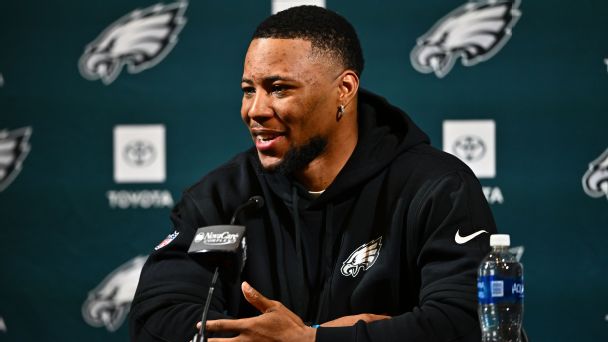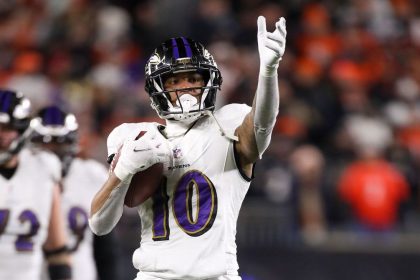
As we get closer to the NFL draft, let’s go back and focus on free agency and the moves that will make a fantasy football impact on the 2024 season. We had some quarterback movement this offseason, along with some veteran running backs and wide receivers, who are now set up to produce based on scheme and team fit.
So, let’s get into it. Here are my favorite fantasy offseason moves, starting in Philadelphia with running back Saquon Barkley.
I’m all-in on Barkley here. Over six seasons in New York, Barkley averaged 98.8 scrimmage yards per game, while logging 288 receptions and 47 total touchdowns. He’s a true dual-threat back, with explosive traits and home run juice. Now, let’s put Barkley in coordinator Kellen Moore’s system behind a premier Eagles offensive line and give him three-down volume.
Zone and gap run schemes. Natural cutback lanes off the read concepts with quarterback Jalen Hurts. The receiving volume too, including screens and deployed matchups to work the underneath levels.
Yes, Barkley needs to remain on the field, as he has missed 25 pro games due to injuries. And he will lose some goal line/low red zone carries to Hurts. However, this is an upgraded system fit for Barkley in Philly, where I expect him to produce breakout games and RB1 numbers in ’24.
Brown is an upgrade for Patrick Mahomes and Andy Reid, adding a more consistent vertical stretch element to the Kansas City offense. In six seasons, Brown has produced 53 explosive-play receptions (20 or more yards). He can get loose over the top of the defense. Brown can also win at the intermediate levels or produce on screens, where we will see his ability after the catch, as 29.8% of his career receiving totals have come after the catch.
In Reid’s offense, Brown will see his one-on-one targets and deep-ball throws. But let’s not forget that the Chiefs’ passing game is heavily schemed, which will create vacated voids in the coverage for Mahomes to target Brown at all three levels of the field. Working with tight end Travis Kelce and wide receiver Rashee Rice, Brown should be expected to produce WR3 numbers in this offense, and he has big-play upside.
Don’t expect a major bump in production from Cousins with the Falcons, as he will remain a borderline QB1 in ’24. However, the addition of Cousins, who can play as a ball distributor in Atlanta’s system, elevates the fantasy profiles of tight end Kyle Pitts, wide receiver Drake London and running back Bijan Robinson.
Pitts, despite his high-end traits at the position, averaged just 8.1 PPG in ’23, while London checked in at 10.1. Robinson did catch 58 passes; however, I believe he will be deployed more as a matchup target for Cousins under offensive coordinator Zac Robinson, creating open-field opportunities.
Remember, Cousins sees it really fast from the pocket, delivering the ball with timing and location. And he can attack the edges on boot/play-action. With those passing traits, Cousins can unlock the potential of this Falcons pass game.
Henry averaged 14.5 PPG last season in Tennessee, but he’ll see an upgraded offensive front and run game in Baltimore. The Ravens led the NFL in 2023 with 541 rushing attempts, and I expect the run script under coordinator Todd Monken to be even more multiple as Henry pairs with quarterback Lamar Jackson in the backfield.
Yes, we still see downhill power here. Let’s get Henry on a north/south track and also cater to his vision/cutback ability on zone schemes. That includes goal-line carries, too. But I’d keep an eye on how Monken schemes for the threat of Jackson as a runner, which will create more conflict for opposing defenses on the edges, thus opening lanes for Henry.
I know Henry is 30 years old and the play speed could decline soon. But given how the Ravens use the run game as a foundational aspect of their offense, Henry will see the volume and scoring opportunities to potentially produce low-end RB1 numbers in ’24.
We don’t hit on the productive players re-signing with their teams enough, so let’s focus on the Bucs here. Mayfield posted 19 or more fantasy points in three of the final five weeks of the 2023 season, including a season-high 29 points in the Week 15 win over the Packers. With his aggressive throwing mindset and arm talent, Mayfield should be on your streaming radar in 2024, in addition to the upside he brings to 2QB Superflex formats.
Evans, who played in all 17 games last season, led the league with 13 touchdown receptions and averaged 16.6 fantasy PPG. He’s the prototypical boundary X receiver with third-level explosive-play ability, matchup traits/frame in the red zone and the route-running chops to separate in the middle of the field. And the play speed is still there on the tape. Evans will be a draft target for me again.
With an upgrade in quarterback talent and the offensive structure in Buffalo, let’s keep Samuel on the radar as a potential flex option. Last season with the Commanders, Samuel caught 62 passes for 613 yards, including four touchdown grabs. He has the versatility to align on the boundary or in the slot and the motion/movement skills to be schemed on manufactured touches (fly sweeps, screens, backfield touches). And I see Bills offensive coordinator Joe Brady deploying Samuel as a middle-of-the-field stretch target, too.
Receivers Stefon Diggs and Khalil Shakir and tight end Dalton Kincaid are in the mix here, so there will be competition for target volume in Buffalo. I get it. But in an offense that can be explosive and score points with quarterback Josh Allen, Samuel’s overall versatility can be maximized this season to create fantasy production.
The Houston offense, led by quarterback C.J. Stroud, is loaded with young talent and a creative playcaller in Bobby Slowik. But this is a unit that also averaged just 3.7 yards per carry last season, which ranked 29th in the NFL. Mixon should be seen as an upgrade here, given his veteran running traits, goal-line vision/power and the skills he brings as a receiving target out of the backfield.
Mixon rushed for 1,034 yards and nine touchdowns last season in Cincinnati and has seen 200 or more carries in five of his seven seasons. He’ll command lead-back volume in a Houston, while giving Stroud a productive option in the screen game and as an underneath outlet versus zone coverage. Mixon fits a reliable RB2 in fantasy next season with the ability to produce RB1 numbers, depending on the matchup.
With a switch in offensive structure that figures to be more pass-heavy under new coach Brian Callahan, Ridley enters a situation where he can produce WR2 numbers in ’24. Working opposite of DeAndre Hopkins, look for Ridley to be deployed as a multilevel target, using his ball-tracking ability on verticals and his sudden movement traits to separate on in-breakers and isolation matchups.
In Jacksonville last season, Ridley averaged 13.5 fantasy PPG, but he did log six games with 20 or more points. Yes, we will need to see Tennessee quarterback Will Levis make that second-year jump, but there’s no question on his arm talent or throwing traits. Adding a threat like Ridley can accelerate Levis’ development at the position.









